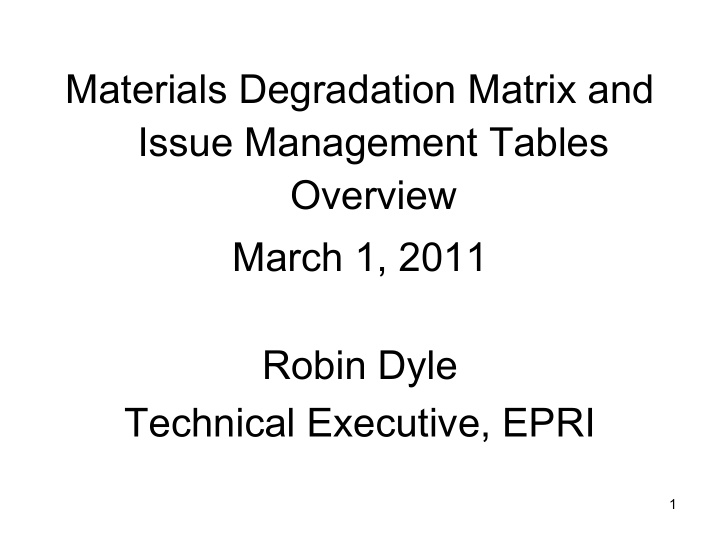



Materials Degradation Matrix and Issue Management Tables Overview March 1, 2011 Robin Dyle Technical Executive, EPRI 1
Materials Initiative NEI 03-08 • NEI 03-08 became effective January 2004 • Genesis of current materials focus • Established strategic oversight by CNOs • Elevated the expectation for proactive and strategic management of materials aging • Brought multiple programs under one umbrella 2
Programs Under NEI 03-08 Today • EPRI –BWRVIP –NDE APC –MRP –PSCR –SGMP –Water Chemistry Committee • PWROG MSC 3
Implementation Tools • Tools needed to effectively manage multiple groups with varied scopes • Developed a Strategic Plan • Materials Degradation Matrix (MDM) • Issue Management Tables (IMTs) 4
Materials Degradation Matrix (1) • Identify all relevant materials • Develop a fundamental understanding of degradation phenomena/mechanisms • Identify knowledge gaps and potential areas for additional research 5
Materials Degradation Matrix (2) • Rev. 0 & NUREG-CR-6923 (PMDA) aligned on key issues • Rev 2, published August 2010 considered: –Operating Experience (US and International) –New Research Results –Materials Aging for 80-year plant operation 6
Issue Management Tables (1) • Evaluates MDM gaps based on safety and operational impact • Prioritize projects for gap closure including Inspection, Mitigation Repair & Replace options • Prioritize Research 7
Issue Management Tables (2) • Identify License Renewal needs/options • Share issues and priorities with NRC • Rev. 2 of the BWR and PWR IMTs reflect Rev. 2 of the MDM (80 years) 8
Current Focus • Environmental Effects on Fracture Resistance • Environmental Effects on Fatigue Life • SCC of Ni-Base Alloys and Stainless Steels • Effect of Fluence on SCC Susceptibility and Crack Growth Rates • Effect of Fluence on Reactor Vessels • PWR Reactor Internals Inspections • Alloy 52 welding issues 9
Conclusion • NEI 03-08 provided strategic framework for materials aging management • Use of MDM/IMT led to: – Better tools to address aging management for current and license renewal terms – More proactive research on aging and mitigation options – Appropriate Inspection Programs – Integrated strategy across the fleet with CNO engagement and oversight – Effective communication with NRR and RES 10
Acronyms (1) • NEI - Nuclear Energy Institute • CNO - Chief Nuclear Officer • BWRVIP – Boiling Water Reactor Vessel Internals Project • NDE - Non-destructive Examination • APC – Action Plan Committee • MRP – PWR Materials Reliability Project • PSCR – Primary Systems Corrosion Research Committee • SGMP – Steam Generator Management Program 11
Acronyms (2) • PWROG MSC - PWR Owners Group Materials Subcommittee • MDM - Materials Degradation Matrix • IMTs - Issue Management Tables • PMDA – Proactive Materials Degradation Assessment • SCC – Stress Corrosion Cracking • PWR - Pressurized Water Reactor • BWR – Boiling Water Reactor 12
Recommend
More recommend